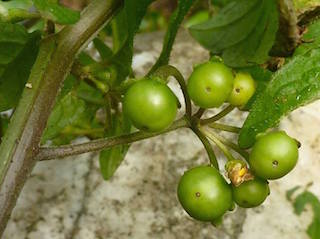
In late summer and into autumn, look out for the white flowers and bright yellow stamens of Black Nightshade on waste ground and nutrient-rich soils.
Photo: Krzysztof Ziarnek, Kenraiz, CC BY-SA 4.0, via Wikimedia Commons
Scientific name: Solanum nigrum
Other common names: Garden Huckleberry, Duscle, Garden Nightshade, Hound’s Berry, Petty Morel, Wonder Berry, Small-fruited Black Nightshade, Popolo
What to look for:
- Family: Solanaceae (Nightshade family).
- Flowers: Greenish-white petals and yellow anthers.
- Leaves: Leaves, alternate, up to 7 cm long, diamond-shaped.
- Fruit: Berries up to 8 mm diameter; berries starting green and blackening when ripe.
- Height: Up to 60 cm.
- Where: Native to Eurasia, including Britain. Found on wastelands and cultivated ground, nutrient-rich soils.
- When: Usually flowers from July to October.
- Habit: Upright.
With its white flowers with their striking yellow stamens, Black Nightshade is a striking plant of waysides, waste ground and cultivated land, which occasionally makes its way into gardens. Native to the UK it is more common in the south than the north.
One way to distinguish Black Nightshade from its more toxic cousin, Deadly Nightshade (Atropa belladonna), is by the berries, which are borne singly on the latter but in bunches on the former. That isn’t to say that Black Nightshade doesn’t contain toxins. Its toxicity is however very variable, and some strains are in fact cultivated as a food crop, while it has a long history of use in herbal medicine across many cultures. However, the unripe (green) fruit contains the toxin solanine, so the plant should be avoided as a food plant unless you are an expert forager and can identify different strains of the species.


Did you know…?
…Two sub-species of S. nigrum are found in Britain, S. nigrum ssp. nigrum, and S. nigrum ssp. schultesii. The former is more common, while the latter is mainly found in southeastern England.
… Nightshades are in the same family as tomatoes and potatoes.
More information and references:
Rose, F. and O’Reilly, C., 2006. The Wild Flower Key, 2nd edition. Frederick Warne, London.
Stace, C., 2010. New Flora of the British Isles, 3rd edition. Cambridge University Press, Cambridge.
Published: December 2015
Author: Amanda Scott
Photos: Flowers – Krzysztof Ziarnek, Kenraiz, CC BY-SA 4.0, via Wikimedia Commons; berries – Steve Townsend
